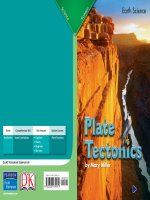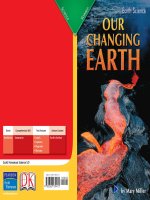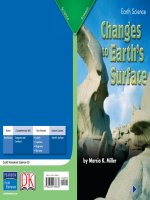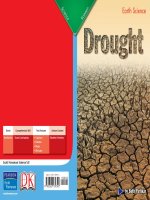3 7 fertile floods (earth science)
Bạn đang xem bản rút gọn của tài liệu. Xem và tải ngay bản đầy đủ của tài liệu tại đây (3.05 MB, 10 trang )
Genre
Nonfiction
Comprehension Skill
Compare and
Contrast
Text Features
•
•
•
•
Captions
Diagrams
Labels
Glossary
Science Content
Rocks and Soil
Scott Foresman Science 3.7
ISBN 0-328-13828-2
ì<(sk$m)=bdicij< +^-Ä-U-Ä-U
Vocabulary
Extended Vocabulary
decay
igneous rock
loam
metamorphic rock
mineral
nutrient
rock
sedimentary rock
soil
delta
drought
famine
fertilize
floodplain
irrigate
oasis
What did you learn?
1. What makes a fertile flood so good
for the farmers and the community?
2. What are some of the natural events
that will cause the rivers to flood in
Bangladesh?
by Kristin Cashore
3. What makes the Okavango River
different from the other rivers you
read about in this book?
4.
In this book you
read about the flooding of the Nile
River and the building of the Aswan
High Dam. Write to explain how the
Aswan High Dam has changed the
behavior of the Nile River. Give
examples of both good and bad
effects of the Aswan High Dam.
5.
Compare and Contrast What are
the similarities between irrigating
and fertilizing? What are the
differences?
Picture Credits
Every effort has been made to secure permission and provide appropriate credit for photographic material.
The publisher deeply regrets any omission and pledges to correct errors called to its attention in subsequent editions.
Photo locators denoted as follows: Top (T), Center (C), Bottom (B), Left (L), Right (R), Background (Bkgd).
1 Mike Surowiak/Getty Images; 6 ©Airphoto; 9 (T) Robert Harding World Imagery/Alamy Images,
(B) John Hepver/The British Museum/DK Images; 11 NASA/Photo Researchers, Inc.; 12 (B) Trygve Bolstad/Panos Pictures;
13 Ian Berry/©Magnum Photos; 14 (BL) Martin Harvey/NHPA Limited.
Unless otherwise acknowledged, all photographs are the copyright © of Dorling Kindersley, a division of Pearson.
ISBN: 0-328-13828-2
Copyright © Pearson Education, Inc. All Rights Reserved. Printed in the United States of America.
This publication is protected by Copyright, and permission should be obtained from the publisher prior to any
prohibited reproduction, storage in a retrieval system, or transmission in any form by any means, electronic,
mechanical, photocopying, recording, or likewise. For information regarding permission(s), write to
Permissions Department, Scott Foresman, 1900 East Lake Avenue, Glenview, Illinois 60025.
3 4 5 6 7 8 9 10 V010 13 12 11 10 09 08 07 06 05
What You Already Know
A rock is a solid, nonliving material made
of minerals. There are three kinds of rock.
Igneous rock forms from molten minerals and
gases. Sedimentary rock forms from sediments.
Metamorphic rock is rock that has been changed
because of heat, pressure, or both.
Minerals form from nonliving matter.
You can identify a mineral by its color, streak,
and other properties. Most things that we use
contain minerals.
Air, water, and rock particles make up three
of soil’s four ingredients. Sands, silts, and clays
account for soil’s rock particles. These rock
particles contain minerals that
are rich in nutrients.
The fourth ingredient in soil
is humus. Humus is made up
of dead and decaying plants
and animals.
Crops grow best in soil that has a lot of water
and nutrients. One of the best soils for crops
is called loam.
Most land gets its water from rain. However,
some places get their water through flooding. People
usually think of floods as being harmful events that
hurt the land and its living things. But some floods
bring water and needed nutrients to dry land. In this
book you will learn about these kinds of floods.
flooded rice field
metamorphic rock
2
3
Facts on Floods
Floods are caused by overflowing bodies of
water, including rivers, lakes, and streams. They
are also caused by groundwater rising up to the
surface and overflowing the land. When the soil
becomes saturated, meaning when it can’t hold
any more water, its water table, or the top layer
of groundwater, floods the land.
A flood can be one of the most harmful
forces in nature. It can harm people and crops,
ruin homes, and spread diseases. However, there
are some places where floods bring important
benefits. People depend on some annual floods to
bring water and minerals to the land.
Farmers often grow rice
near flooding rivers. Rice
grows well in this flooded
paddy field.
Historically, rivers like the Nile in Egypt have
flooded regularly. The Nile’s waters irrigate
the land. Irrigation makes the soils of the Nile
floodplain some of the most fertile in the world.
Quick quiz: What did the ancient civilizations of
Egypt, Mesopotamia, China, and India all have in
common? Answer: They all developed along huge
rivers. The irrigation provided by their rivers’
annual floods supported farming, trade, and many
other activities.
Flooding rivers carry silt. This silt is rich
in nutrients. It fertilizes the land and creates
productive farmlands when flood waters deposit it
there. If it weren’t for these fertile floods, drought
and famine might happen in many places.
river in flood
The Thames (TEMZ) Flood Barrier was
built to prevent flooding in London.
4
floodplain
The floodplain is the low area covered
by a river during a flood.
5
Deltas
So how does a flooding river work? As
it moves downhill over rocks and land, it
collects soil particles rich in nutrients. When
the river reaches flatter ground, it slows down.
Most rivers flow into a lake, sea, or ocean.
When a river reaches the lake, sea, or ocean,
it drops its particle load. Over a long period
of time, this material forms an area of land at
the mouth of the river, called a delta. Deltas
are made fertile by the nutrients they receive
from floods. There are fertile deltas all over
the world.
For people who live near these deltas, the river
can be both a friend and an enemy.
If the river does not flood enough, people may
suffer drought and famine. If it floods too much,
then property is damaged and people are hurt. So
everyone hopes the river floods just enough!
When rivers flood, they do more than irrigate
floodplains and spread minerals. They also change
the shape of the land. Some land gets eroded, or
washed away. Other land gets this washed away
material, which builds up. And the river itself
sometimes changes its course.
To prevent such changes, many
countries have dammed their major
rivers. Later you will read about
the damming of the Nile and
its results.
Rivers move quickly on
steep land. When they
reach level land, they slow
down and spread out.
Floodplain
The Mississippi Delta covers an enormous amount of
land in the southeastern United States.
6
Delta
7
The Nile
The Nile River is the longest river in the
world. It has always been the center of life for
Egyptians. The capital of Egypt, Cairo, is on
the Nile. So is Khartoum, the capital of Sudan.
Farther to the south, a branch of the Nile begins
at Addis Ababa, the capital of Ethiopia.
Although the Nile flows for hundreds of miles
in Egypt, it gets its water from countries such
as Ethiopia. It rains a lot in Ethiopia during the
summer. For thousands of years the Nile carried
the water from Ethiopia’s rains all the way to
Egypt. In the past this caused flooding.
These fertile fields were watered
by the flooding of the Nile.
The Nile brings life to the dry lands on either side of it.
When the Nile flooded, it made the narrow
strip of land on either side of the river very
fertile. The flooding river provided the water and
nutrients needed to grow crops.
Sometimes the river rose too much or not
enough. In the worst years it didn’t rise at all,
leading to terrible drought and famine. The corn,
rice, wheat, and other crops grown along the
Nile needed a lot of people to tend to them, so
families started having more children. This made
the famine years even worse, because there were
so many more mouths to feed.
The Egyptian government decided to take
steps to try to solve the problems created by
drought and famine. They built the Aswan
High Dam.
ancient Egyptian
carving of a
farmer plowing
a field
8
9
le
Ni
The Aswan High Dam, built in
1970, has stopped the Nile’s annual
floods and controlled the water
supply. During rainy years it stores
EGYPT
water. During times of drought
it releases water. The dam also
generates electricity for all of Egypt.
Aswan High Dam
The Aswan High Dam keeps
Lake Nasser
people and houses safe from
SUDAN
floods. It also helps prevent
drought and famine. However, the The Nile River
dam has also had some very bad
and the Aswan
effects. By stopping the floods it has High Dam
prevented the silt suspended in the
water from reaching the land. This has forced
Egyptian farmers to use man-made fertilizers.
As time passes, their land grows more dry and
unhealthy without the traditional silt deposits.
These temple
ruins needed
to be moved to
higher ground
after the
Aswan High
Dam was built.
10
This is a satellite image
of the Aswan High
Dam. The dam holds
back a huge reservoir
of water.
Aswan
High Dam
Because the dam held back
the flow of the Nile, some of
the lands behind the dam were
permanently flooded. Thousands
of people who lived on these lands
had to leave their homes. Some
ancient Egyptian relics were lost
under the water. The Egyptians
tamed their wild river, but their
land would never be the same.
11
Bangladesh
Bangladesh is a small
country near India. The
Ga
BANGLADESH
deltas of three big rivers, the
M
Ganges, the Brahmaputra, and
the Meghna, form much of
Bangladesh’s land. These
rivers start all the way up in
Bangladesh’s
the Himalayas. They end at
flooding regions
the Indian Ocean.
Bangladesh floods if there is a
lot of snow melting in the
Himalayas. It also floods if
there is heavy rain upstream in
India and elsewhere. The yearly
rainstorms, called monsoons,
also flood Bangladesh. The
floods bring rich silt deposits,
which make Bangladesh one
of the most fertile places in
the world.
utra
Brahmap
ng
es
a
hn
eg
Farmers in Bangladesh
are used to flooding. Many
of them build their houses
on stilts. That way when
the floods come, the people
don’t have to leave! However,
some years the flooding
causes terrible devastation.
It harms people and animals,
washes away houses, and
destroys crops. The farmers
who live near Bangladesh’s
rivers must always be alert.
Many Bangladeshi people
have adopted ways to
live above the floods.
Bangladesh’s flat land and
many rivers flood easily.
12
13
Okavango Delta
The Okavango River originates in Angola
and flows through Namibia and Botswana, in
southern Africa. This river is unique. It does not
end at a lake, sea, or ocean. Instead, it ends at a
wetland in the middle of the Kalahari Desert.
This wetland is called the Okavango Delta, and
it is one of the largest inland deltas in the world.
The Okavango Delta is an oasis of life in
the harsh desert. It floods every summer. This
flooding irrigates and fertilizes the delta so that
a variety of plants and animals
can grow and live there.
ANGOLA
Whenever a river floods, it can cause
destruction. But sometimes people depend
upon floods to fertilize and irrigate their
lands. Sometimes flooding even helps plants
and animals.
Rivers are not predictable. Sometimes they’re
supposed to rise, but fail to. Other times they
do rise, but when they’re not expected to! In the
best years, rivers rise just the right amount, at
just the right time. This is when the people and
the land are happy to have a fertile flood!
These elephants would not have
enough to eat if it weren’t for the
flooding of the Okavango.
go
an
av
NAMIBIA
O
k
Okavango
Delta
BOTSWANA
Okavango Delta
The annual floods of the
Okavango bring life to
the Kalahari Desert.
14
15
Vocabulary
Glossary
decay
Extended Vocabulary
delta
igneous rock an area ofdrought
delta
land that usually forms
loam
famine
near the mouth of a river
metamorphic rock
fertilize
mineral
floodplain
drought
a severe shortage
of water,
nutrient
irrigate
caused by lack of rain or lack
rock
oasis
of expected
flooding
sedimentary rock
soil
famine
a food shortage that causes severe
hunger and starvation
fertilize
to supply the minerals and
nutrients that plants need to grow
What did you learn?
1. What makes a fertile flood so good
for the farmers and the community?
2. What are some of the natural events
that will cause the rivers to flood in
Bangladesh?
3. What makes the Okavango River
different from the other rivers you
read about in this book?
4.
In this book you
read about the flooding of the Nile
River and the building of the Aswan
High Dam. Write to explain how the
Aswan High Dam has changed the
behavior of the Nile River. Give
examples of both good and bad
effects of the Aswan High Dam.
5.
Compare and Contrast What are
the similarities between irrigating
and fertilizing? What are the
differences?
floodplain
the area on either side of a river
that is covered with water during
Picture Credits
a flood
Every effort has been made to secure permission and provide appropriate credit for photographic material.
The publisher deeply regrets any omission and pledges to correct errors called to its attention in subsequent editions.
Photo locators denoted as follows: Top (T), Center (C), Bottom (B), Left (L), Right (R), Background (Bkgd).
irrigate
to transport water to plants to
help them grow
1 Mike Surowiak/Getty Images; 6 ©Airphoto; 9 (T) Robert Harding World Imagery/Alamy Images,
(B) John Hepver/The British Museum/DK Images; 11 NASA/Photo Researchers, Inc.; 12 (B) Trygve Bolstad/Panos Pictures;
13 Ian Berry/©Magnum Photos; 14 (BL) Martin Harvey/NHPA Limited.
Unless otherwise acknowledged, all photographs are the copyright © of Dorling Kindersley, a division of Pearson.
oasis
a fertile spot in the middle of
the desert, caused by the presence
ISBN: 0-328-13828-2
ofRightswater
Copyright © Pearson Education, Inc. All
Reserved. Printed in the United States of America.
This publication is protected by Copyright, and permission should be obtained from the publisher prior to any
prohibited reproduction, storage in a retrieval system, or transmission in any form by any means, electronic,
mechanical, photocopying, recording, or likewise. For information regarding permission(s), write to
Permissions Department, Scott Foresman, 1900 East Lake Avenue, Glenview, Illinois 60025.
3 4 5 6 7 8 9 10 V010 13 12 11 10 09 08 07 06 05
16









